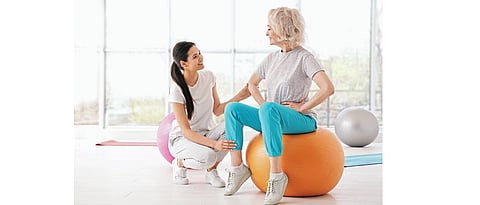

Do you know that 20 per cent of bone loss in women happens five to seven years after menopause? Post-menopausal osteoporosis is a condition that weakens bones and over time they become weaker and more brittle. Dr Agnivesh Tikoo, consultant and spine surgeon at Apollo Hospitals, Navi Mumbai, says that lower back pain and osteoporosis are two of the most common conditions reported by post-menopausal women.
According to the 2011 census of India, there were about 96 million women aged over 45 years and this number is expected to increase to 401 million in 2026. Thus, talking about menopause and how to deal with post menopausal conditions is important. Tikoo tells us more about the condition, its effects and how to prevent it. Excerpts:
What is post-menopausal osteoporosis?
Essentially the bone becomes more ‘porous’, or weak. People with osteoporosis are more prone to fractures and multiple spine wedging (fractures) resulting in loss of height. These fractures are much worse than regular fractures. Fractures in weak bones are caused by minor or trivial injuries and may result in permanent disability or even death. Women are at a much higher risk of developing osteoporosis.
What are some of the common factors that give rise to this kind of condition?
The main reason why women especially are prone to developing osteoporosis post-menopause is a drop in the estrogen level. The hormone estrogen is crucial for monitoring bone turnover in adults. After the periods stop in females, a person goes through bone breakdown meaning that there is a steady decline in bone mass. This is generally an age-related issue. Beyond a certain point of bone loss, we say that a person has osteoporosis. In the case of post-menopausal women, this is accelerated because of the sudden decline in estrogen.
Today, women not just above 45 years but those even younger complain of lower back pain and weak bones.
Why so?
The bone mass increases steadily till 30 years of age. Less bone mass (strength) at this age would mean more chances of osteoporosis later on. Today’s sedentary lifestyle with no exercises results in weaker stimulus for bones to form. This is often compounded by low vitamin D levels and bad sitting posture. Alcohol also has a bone weakening effect.
Are supplement drinks enough to keep bones healthy?
Vitamin D helps our bones to become strong. One should keep a regular check on Vitamin D levels. Very limited sunlight exposure has left us all prone to developing vitamin D deficiency. A health lifestyle with health food, adequate Vitamin D levels and regular exercises at younger age is the key to good bone health.
Starting a good exercise and diet regimen around the age of 30 is a good way to reduce the risk of post-menopausal osteoporosis. Calcium and Vitamin-D play an important role in bone strength. Dairy products such as milk, curd, paneer, almonds, okra, rajma and ragi or good sources of calcium also help. One should rely more on natural sources of calcium than depending on tablets. By letting the sun’s rays touch us for 15-30 minutes twice a week, will form required amount of Vitamin-D. Fatty fish is also another good source of Vitamin-D.
What are some dos and don’ts women need to follow post menopause?
In order to prevent post-menopausal osteoporosis, it is a must for women to pay more attention to their bone health 15-20 years before menopause. Sometimes hormone therapy is prescribed to improve bone health but has its own risks. Regular check-ups are a must — osteoporosis is a ‘silent disease’ because it gradually develops and patients start to feel its effects at a very late stage. Maintaining a healthy weight, doing exercises, avoiding smoking/alcohol, increasing fruits, vegetables, nuts and whole-grain foods are some example of ways women can maintain good health post menopause. One should also regularly check Vitamin D levels.
